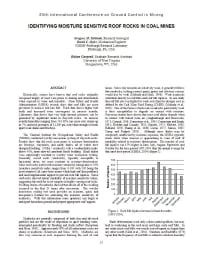Mining Publication: Identifying Moisture Sensitive Roof Rocks in Coal Mines
Original creation date: August 2006
Authors: GM Molinda, DC Oyler, H Gurgenli
NIOSHTIC2 Number: 20030806
Proceedings of 25th International Conference on Ground Control in Mining, August 1-3, 2006, Morgantown, West Virginia. Peng SS, Mark C, Finfinger G, Tadolini S, Khair AW, Heasley K, Luo Y, eds., Morgantown, WV: West Virginia University, 2006 Aug; :57-64
Historically, miners have known that roof rocks originally composed largely of mud were prone to slaking and deterioration when exposed to water and humidity. Mine Safety and Health Administration (MSHA) records show that roof falls are more prevalent in summer and late fall. Field data shows higher bolt loads and increased room convergence in summer months. Laboratory data shows that very high internal pressures can be generated by significant strain in clay-rich rocks. In summer months humidities ranging from 70-100% can cause rock strains up to 7%, and rock pressures of 14,000 psi, more than enough to break apart weak shales and fireclays. The National Institute for Occupational Safety and Health (NIOSH) conducted wet/dry immersion cycling of clay-rich rocks. Results show that the rocks most prone to moisture deterioration are fireclays, claystones, and sandy shales, all of which have disrupted bedding. Of the 7 mudrocks with a weatherability index above 40%, none showed consistent fissile bedding. Black shales were surprisingly resistant to wet/dry water immersion cycling. Generally, mixed rocks (stackrock), typically susceptible to horizontal stress, are more resistant to moisture-deterioration. Mine roof rocks tested with moisture sensitivity ratings above 50% (moisture sensitivity index ranges from 0-100 with 100 being the most sensitive) all came from mines which had roof skin problems and used supplemental support to prevent rock fall injuries. Some roof rocks showed lateral variability of moisture sensitivity values, suggesting the need for more samples in highly varying roof rocks. Swelling strains of mudrocks showed that almost all of the swelling occurred in the first 24 hours after immersion. The wet/dry immersion cycling test used provides an accurate, quick and inexpensive method for estimating the moisture sensitivity of mudrocks. With this information mine operators can begin to anticipate hazardous ground and prepare appropriate roof support.

NIOSHTIC2 Number: 20030806
Proceedings of 25th International Conference on Ground Control in Mining, August 1-3, 2006, Morgantown, West Virginia. Peng SS, Mark C, Finfinger G, Tadolini S, Khair AW, Heasley K, Luo Y, eds., Morgantown, WV: West Virginia University, 2006 Aug; :57-64
- Building Capacity and Enhancing Long-Term Coal mine Weak Roof Stability through Characterization and Modeling of Time-Dependent and Moisture-Sensitive Failure in Shale
- Field Observations and Numerical Studies of Horizontal Stress Effects on Roof Stability in U.S. Limestone Mines
- Geologic Factors Causing Roof Instability and Methane Emission Problems: The Lower Kittanning Coalbed, Cambria County, Pa
- Geologic Hazards and Roof Stability in Coal Mines
- Horizontal Stress
- Mapping Hazards with Microseismic Technology to Anticipate Roof Falls - A Case Study
- New Developments with the Coal Mine Roof Rating
- Optimizing Secondary Roof Support with the NIOSH Support Technology Optimization Program (STOP)
- Shale Failure Mechanics and Intervention Measures in Underground Coal Mines: Results from 50 Years of Ground Control Safety Research
- Technology News 483 - Safety Training Tools for Rock Scaling Personnel